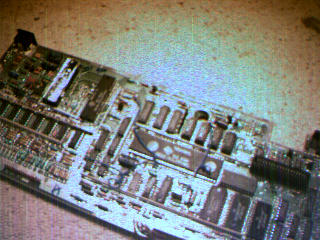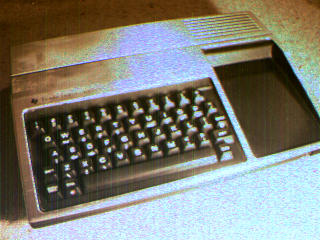tapeth represents the type of computer which was the first my family ever owned. The TI was the machine I first learned to program on, and I have a certain affection for it as a result.
I have a number of users' club magazines for the TI, including some hardware projects for expanding it. The console unit alone is very basic: it uses cassette tape for storage and a TV for a display. You could buy a large peripheral expansion unit for it which permitted the addition of floppy drives and more memory.
Curiously enough for its time, the 99/4a is actually a 16 bit machine,
(to be precise, 16bit databus + 16bit address bus + 14bit VDP address bus
+ 16bit GROM address bus [see below])
using the TMS9900 CPU. Unfortunately, TI crippled the machine with a
weird architecture. There are actually only 256 bytes of RAM
connected directly to the CPU. Most of the memory of a TI is either
VDP RAM or Graphics RAM (GRAM), accessible only one word at a time.
VDP RAM can only be accessed via the Video
Display Processor; it contains the on-screen image and is also used to
store BASIC programs(!). GRAM/GROM is used to store Graphics Programming
Language (GPL) programs. These are interpreted by a GPL interpreter
residing in real CPU ROM. Believe it or not, the BASIC interpreter is a
GPL program. This means that it must in turn be interpreted by the GPL
interpreter, and the whole machine is correspondingly slow...
A console contains:
Much of this information is from an article by R.A. Green in TI*MES issue 17.
tapeth was originally owned by a friend's family. Like the one I used to own (which is unfortunately no longer in existence) it was bought for a very low price in 1984, immediately after Texas announced that they were leaving the home computer market and would no longer market the 99/4a.

